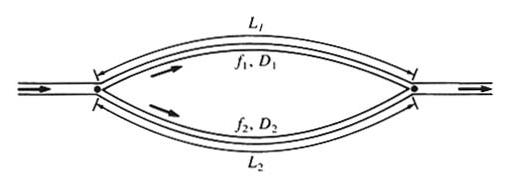CIV E 444 - APPLIED HYDRAULICS
SPRING 2016
HOMEWORK No. 8
- A concrete-lined tunnel has a compound rectangular-semicircular cross-section shown in the figure below. The discharge when flowing full is 4,000 cfs.
The bottom width is 18 ft. The water temperature is 70° F. What is the head loss in ft/mile? Assume roughness of concrete ks (rough surface) = 0.01 ft.

- The conduit of the previous example is used to convey water from a reservoir at elevation 3,250 ft, through a power plant, and then to discharge to a lake at elevation 1,575 ft. The pipe is 8,550 ft long, has one 45o bend with relative radius r/d = 2, an inlet with relative radius r/d = 0.25, and an outlet with angle θ = 180o and relative diameter D1/D2 = 0.4. How many megawatts of power can be realized if the head loss associated with the turbines is 0.25 of the velocity head?
- Assume three reservoirs A, B, and C connected as shown below. The elevations (relative to C) are: zA = 100 ft, zB = 150 ft, zD = 10 ft.
Line AD is 4,000-ft long and 8-in diameter; BD is 10,000-ft long and 10-in diameter; DC is 5,000-ft long and 12-in diameter. Calculate the discharge in each pipe
and the head at D. Assume f = 0.02 in all pipes. Neglect minor losses.

- A pipeline carrying Q = 20 cfs of water is divided into two pipes 1 and 2. The diameter, length and friction factor of pipe 1 are 12 in, 3000 ft, and 0.02, respectively.
The diameter, length and friction factor of pipe 2 are 16 in, 3200 ft, and 0.03, respectively. Calculate the discharge in each pipe, and
confirm that Q1 + Q2 = Q.
Calculate the head loss through each pipe and confirm that they are the same.
